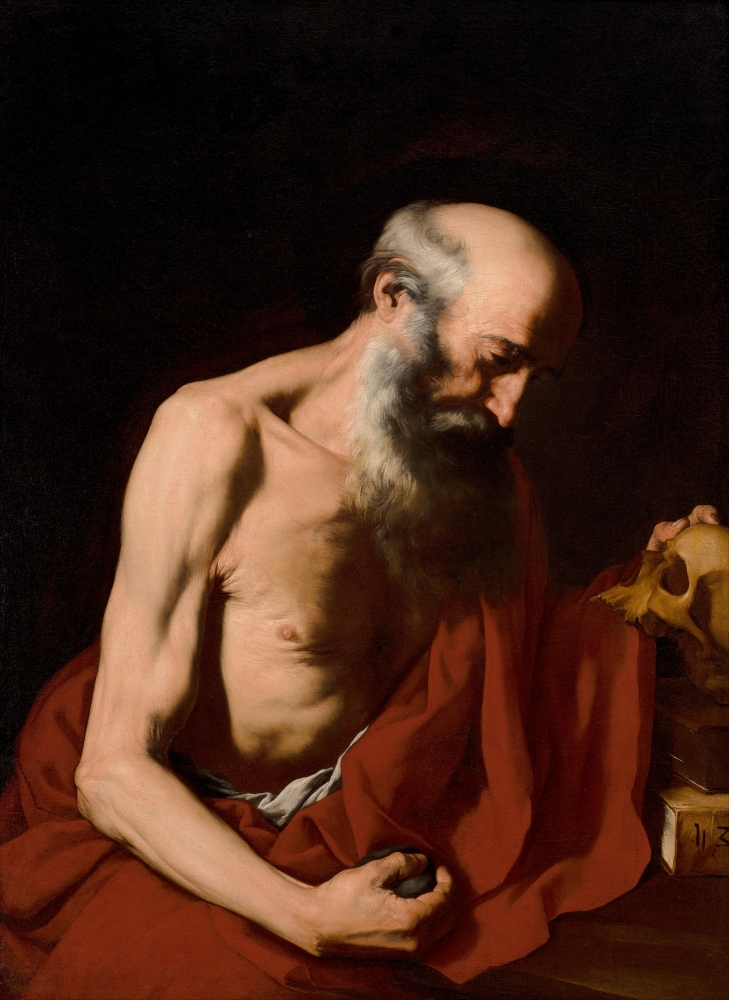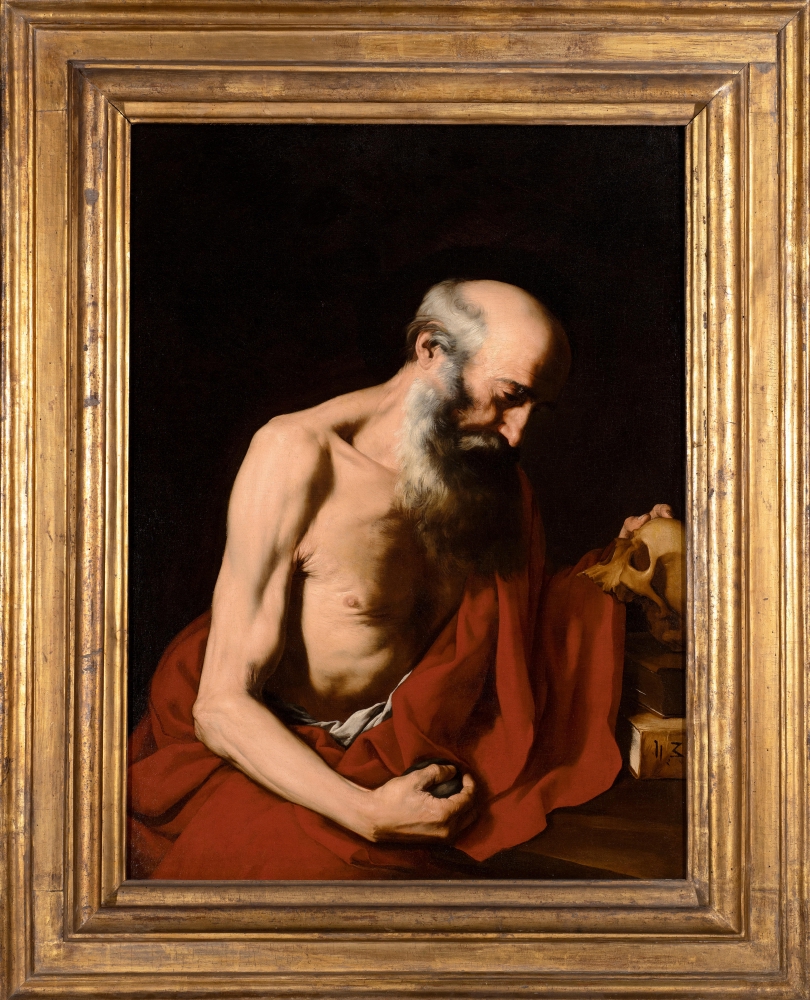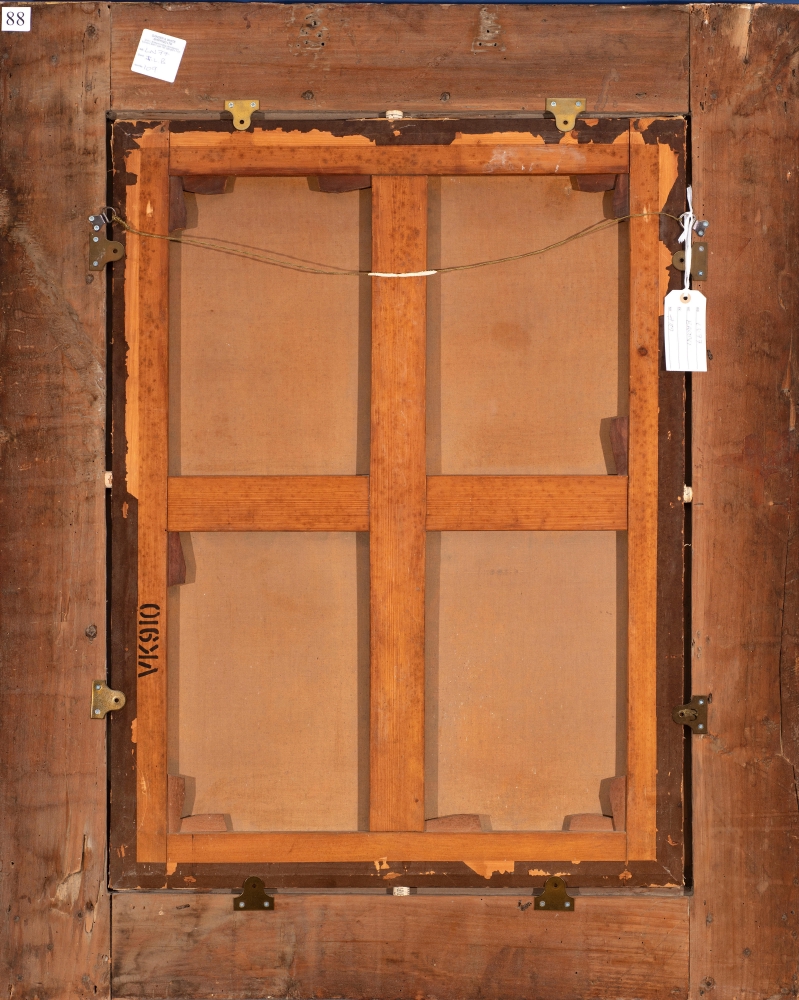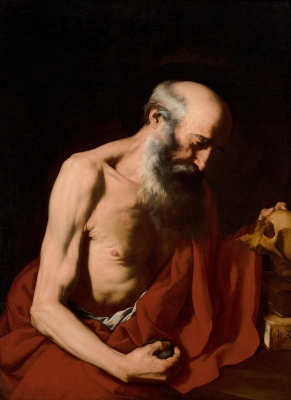Madame de Magnanville;
Her sale (Lugt 83654), Versailles, Hôtel des Ventes, 16 – 17 May 1922, lot 10, as ‘Ribera (José, dit l’Espagnolet)’;
Private collection, France;
Sale (‘The Property of a Belgian Collector’), London, Christie’s, 10 December 2003, lot 57;
With Jean Luc Baroni Ltd, London, from whom acquired by the present owner.
Salamanca, Sala de Exposiciones de San Eloy, José de Ribera. Bajo el signo de Caravaggio (1613-1633), April – June 2005, no. 21;
Seville, Museo de Bellas Artes, José de Ribera. Bajo el signo de Caravaggio (1613-1633), September – October 2005, no. 22.
N. Spinosa, Ribera: l’opera completa, Naples 2003, p. 290, cat. no. A130, reproduced in black and white;
N. Spinosa, ‘San Jerónimo meditando’, in José de Ribera. Bajo el signo de Caravaggio (1613-1633), exh. cat., Salamanca 2005, cat. no. 21, pp. 82-83, reproduced in colour;
N. Spinosa, ‘San Jerónimo meditando’, in José de Ribera. Bajo el signo de Caravaggio (1613-1633), exh. cat., Valencia 2005, cat. no. 22, pp. 110-113, reproduced in colour, with a detail of the head and shoulders over two pages and a further colour detail on p. 57;
N. Spinosa, Ribera: L’opera completa, Naples 2006, p. 291, cat. no. A79, reproduced in black and white;
N. Spinosa, Ribera: La obra completa, Madrid 2008, p. 363, cat. no. A99, reproduced in black and white.
Click here to download the factsheet
Jusepe de Ribera originated from Xàtiva, near Valencia in Spain, but settled in Naples in about 1616 when he married the daughter of Giovan Bernardo Azzolino – a late Mannerist painter of Sicilian origin with a busy workshop – and set up his own studio. According to his contemporaries, Ribera had worked first in Parma (where he may have arrived about 1611) and later in Rome, where his paintings in Caravaggio’s naturalistic manner had enjoyed success amongst collectors. His style was highly sought after in Naples: a kingdom with a Spanish viceroy and an opulent court. Native artists had encountered difficulties in meeting the needs of both the aristocracy and the clergy, who had recently undertaken a vast construction programme of new churches and monasteries including the Certosa di San Martino, where Ribera was later to execute magnificent work. Building on the relationships which he had established with important fellow countrymen in Rome, Ribera became court painter to successive viceroys, including Fernando Alfán de Ribera (1583 – 1637), 3rd Duke of Alcalà, and Manuel de Zúñiga y Fonseca (d. 1637), Count of Monterrey, who sent back shiploads of his paintings to Spain.
As Sir Ellis Waterhouse pointed out, Ribera, although a Spaniard, is ‘an Italian painter with a Spanish accent and the dominant figure of the earlier Seicento in Naples and the only one with a truly European reputation’.[i] Sir Ellis also remarked that ‘he introduced new themes into Italian painting and the bent of his taste can be paralleled by certain trends in Neapolitan literature of the time – not only Marino’s doctrine that “the purpose of art is to astonish”, but [also] Basile’s interest in local folklore. Both are reflected in Ribera’s use of common models as vehicles for religious expression. He painted best precisely what he had before his eyes’.[ii]
Recent conservation has confirmed that this intense, contemplative image of The Penitent Saint Jerome was painted in the mid to late 1620s, before Ribera turned away from the strong naturalism of his earlier years for Neo-Venetian colouring. It was previously thought that the present picture had been executed at about the same time as the three-quarter length Penitent St Jerome in the Thyssen Museum, Madrid, which is signed and dated 1634.[iii] Both Dr. Keith Christiansen and Professor Nicola Spinosa, who have examined the painting first hand after cleaning, concur about the revised dating. They place this canvas chronologically between The Vision of St Jerome of 1626,[iv] now in the Capodimonte Museum, Naples, and the painting of the same subject in the Doria Pamphilj Gallery, Rome, which is signed and dated 1629.[v] As Spinosa pointed out,[vi] it shares the same confident, large and fluid brushstrokes, especially in the red of the heavy drapery, that were lacking in many of the artist’s earlier works. There is also identical attention to the careful rendering of skin and flesh and similarly wrought still-life details in the skull and books. Spinosa has compared these skulls to those sculpted by Cosimo Fanzago,[vii] the impressario of the flamboyant Neapolitan Baroque.
Cleaning has also revealed the artist’s monogram on the lower left. It is of a kind that Ribera would seem to have used only on the Prophets of 1638-43 in the nave spandrels of the church of the Certosa.[viii] By that time, however, Ribera’s art had evolved from its tenebrist origins into a personal form of Baroque Classicism, with its lighter Neo-Venetian palette.[ix]
There is a mediocre workshop version of this Penitent St Jerome in the Musée des Beaux-Arts, Pau.[x]
Father of the Church and translator of the Vulgate, St Jerome was born in Dalmatia in 342. As a young man he travelled to the Holy Land, and later went to live as a hermit in the Syrian desert where he studied Hebrew with, in his own words, ‘only the scorpions and the wild beasts for company’. During this period, he experienced vivid sexual hallucinations which he fought off by beating his breast, hence the stone which artists – like Ribera in this picture – put in his hand. He held office in Rome under Pope Damasus I (366 – 384). In 386, St Jerome settled in Bethlehem where he began work on his translation of the Old and New Testaments into Latin, which occupied him for many years. St Jerome is often depicted in Western Art, but rarely as a young man. He is usually shown as an ascetic elderly hermit or, especially in Renaissance painting, in full cardinal’s regalia in a library.
[i] E. Waterhouse, Italian Baroque Painting, London 1962, pp. 174-175.
[ii] Waterhouse 1962, p. 175.
[iii] N. Spinosa, Ribera: l’opera completa, Naples 2003, p. 290, cat. no. A130. In Spinosa’s more recent catalogue raisonné (2008) of Ribera’s work (see Literature), see p. 363, cat. no. A99. For the Thyssen picture, see Spinosa 2003, p. 290, no. A129, reproduced in colour on p. 100. Dr Riccardo Lattuada, in an email of 19 October 2003, stated that in his opinion the present Penitent St Jerome
was an early work dating to 1616-1620, that is to Ribera’s first Neapolitan period, and is comparable to the St Andrew in the Quadreria dei Girolamini, Naples.
[iv] Spinosa 2003, p. 268, no. A56, reproduced in colour on pp. 64 & 65.
[v] Spinosa 2003, p. 272, no. A66, reproduced in colour on pp. 74 & 75.
[vi] Spinosa 2003, p. 103.
[vii] Spinosa 2003, p. 103.
[viii] Spinosa 2003, p. 309, nos. A194 & A195, which are also dated 163(?) and 1640 respectively, p. 310, nos. A197, A198 & A199 and p. 311, no. A200.
[ix] Spinosa 2003, pp. 146 ff.
[x] Spinosa 2003, p. 290, under no. 290. Reproduced in N. Spinosa, L’opera completa del Ribera, Milan 1978, no. 435.



